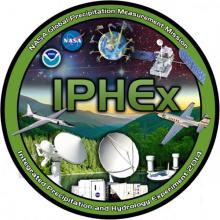 The Global Hydrology Resource Center (GHRC) has published three Global Precipitation Measurement (GPM) Ground Validation datasets from the Integrated Precipitation and Hydrology EXperiment (IPHEX) field campaign held in North Carolina from May 1, 2014 through June 14, 2014. These include the Autonomous Parsivel Unit (APU), the Conical Scanning Millimeter-wave Imaging Radiometer (CoSMIR) and version 2 of the Advanced Microwave Precipitation Radiometer (AMPR). The IPHEX Parsivel dataset additionally includes drop size and distribution measurements from October and November 2013. The CoSMIR data contains well-calibrated radiometric data from 9 channels between 50 and 183 GHz with accuracy on the order of +-1K. All channels besides the 89 and 165.5 GHz are horizontally polarized. Version 2 of the AMPR data has been enhanced to provide field of view water fractions and a quality control metric in addition to the brightness temperatures from version 1.
The Global Hydrology Resource Center (GHRC) has published three Global Precipitation Measurement (GPM) Ground Validation datasets from the Integrated Precipitation and Hydrology EXperiment (IPHEX) field campaign held in North Carolina from May 1, 2014 through June 14, 2014. These include the Autonomous Parsivel Unit (APU), the Conical Scanning Millimeter-wave Imaging Radiometer (CoSMIR) and version 2 of the Advanced Microwave Precipitation Radiometer (AMPR). The IPHEX Parsivel dataset additionally includes drop size and distribution measurements from October and November 2013. The CoSMIR data contains well-calibrated radiometric data from 9 channels between 50 and 183 GHz with accuracy on the order of +-1K. All channels besides the 89 and 165.5 GHz are horizontally polarized. Version 2 of the AMPR data has been enhanced to provide field of view water fractions and a quality control metric in addition to the brightness temperatures from version 1.
GHRC News
Full resolution imagery from the NASA Land Atmosphere Near real-time Capability for EOS (LANCE) Advanced Microwave Scanning Radiometer 2 (AMSR2) processing system at the Global Hydrology Resource Center (GHRC) is now available through the NASA Global Image Browse Service (GIBS) and visible in Worldview. These images include Columnar Cloud Liquid Water, Columnar Water Vapor and Wind Speed over oceans, as well as Surface Precipitation Rate and Surface Rain Rate over land and oceans. More information about LANCE AMSR2 near real-time data is available at http://lance.nsstc.nasa.gov/.
The Advanced Microwave Scanning Radiometer 2 (AMSR2) element of NASA’s Land, Atmosphere Near real-time Capability for Earth Observing Systems (LANCE) generates a suite of Rain and Ocean products from Level-1R resampled brightness temperature data provided by the Japan Aerospace Exploration Agency (JAXA). On June 9, the AMSR Science Investigator-led Processing System (SIPS) reconfigured LANCE AMSR2 processing to use JAXA’s new near-real time (NRT) Level-1R product as input rather than the standard Level-1R product. While the NRT data stream experiences occasional data loss, latency is generally much lower than for the standard data, meaning that AMSR2 products are now consistently generated within three hours of observation, as required by LANCE.
Michael Goodman, former Global Hydrology Resource Center (GHRC) Distributed Active Archive Center (DAAC) Manager supported the 2nd Annual 'NASA on the Square' Bringing Marshall Space Flight Center to Downtown Huntsville, Alabama event on June 21, 2015. The event celebrated Marshall Space Flight Center's past successes and highlighted its current and future work aimed at observing and preserving our Earth, and sending humans to Mars and beyond. The GHRC DAAC distributed 380 "Earth Science Data: Looking for Data?" Lenticular Bookmarks, one box of 2014 Sensing Our Planet, and numerous Earth science posters describing NASA’s research of our atmosphere, land and water.
GHRC DAAC Manager Dr. Rahul Ramachandran made a presentation entitled “Illuminating the Darkness: Exploiting Untapped Data and Information Resources in Earth Science” at the NASA Earth Science Technology Forum 2015, held June 23-25 in Pasadena, CA. The Dark Data project, to innovate and evolve current data and information systems in order to enable data discovery and exploration as an integrated process rather than a series of discrete steps, is funded by NASA’s Advanced Information Systems Technology (AIST) program.
The abstract can be found at http://esto.nasa.gov/forum/estf2015/abstracts/Ramachandran.htm.






